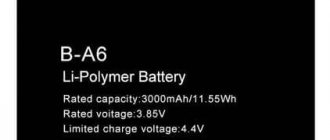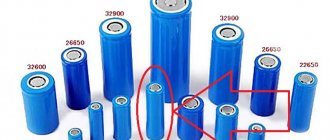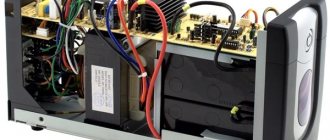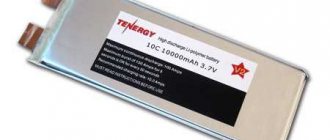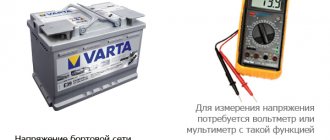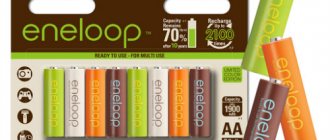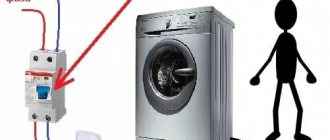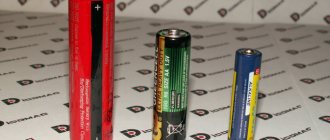A modern person cannot imagine his life without a mobile phone, tablet, laptop, portable drill, screwdriver, flashlight and other devices that can operate either from the mains or from a battery. Often, such devices use lithium-ion power sources.
Many will ask why this type of energy storage device is most often used in electrical appliances. The answer is quite simple and obvious - lithium-ion batteries are small in size, and they also have a fairly long service life - from 300 to 2000 charge-discharge cycles. Precisely because there are so many power sources of this type around us, every person should know how to charge a lithium-ion battery.
What is Li-ion battery
Despite the fact that every person has encountered such a power source, not everyone understands what kind of battery it is and how it works. The simplest and most common option is a lithium-ion power supply for mobile phones. It has the following design: on top there is a controller for charge-discharge control, and below is a battery element (bank).
99% of cell phone batteries use only one battery cell; in their jargon, experts often call it a can. The nominal voltage of this power supply is 3.7 volts.
The device also has a special controller (a regular board with a microcircuit), thanks to which the battery does not overcharge. Therefore, the manufacturer, for its part, did everything possible to ensure that no emergency situations occurred that would lead to a quick breakdown of the power source.
Charging the battery packs
If the device uses not one battery, but a battery pack, the charging circuit assumes that each element of the pack will be charged separately. In this case, a controller board is installed in the battery itself, providing such individual charging to each element.
It happens that manufacturers openly ignore this need when charging battery packs (for example, almost all “power bank” products). This significantly reduces the overall capacity of such an assembly and its service life.
Notebook blocks
Almost all laptop manufacturers artificially limit battery life. The most commonly used is an electronic “cycle counter”. After reaching a certain value, the battery is blocked. 1 cycle = 1 laptop turn on. If the laptop is used primarily as a desktop PC, it is recommended that you remove the battery and install it in the compartment only when needed.
How to charge for the first time
Many probably remember how everyone said that a new battery must be completely discharged, and then fully charged, and this must be done three times.
There really is such a process of first charging, it is actually necessary, but for Ni-Cd and Ni-MH batteries. Such batteries were installed in quite ancient telephones, which are now practically not produced. Not everyone knows how to properly charge a lithium-ion battery for the first time and begins to carry out the procedure of completely discharging it. Batteries of this type are designed completely differently, and the process of deep discharge is very harmful to them. That is why such devices are sold with a charge of 2/3 of the capacity, and not so that a person can check a phone or other device.
Unfortunately, quite often consumers, before charging a lithium-ion battery for the first time, remembering the old days, begin to completely discharge it, thereby almost immediately taking away half of their service life. Therefore, be careful and avoid common mistakes that lead to battery failure.
Maintain temperature conditions
Lithium-ion batteries can operate over a wide temperature range from -20 to +60°C. However, such marginal indicators negatively affect its service life. At negative temperatures (-20°C), they stop delivering current, and at high temperatures (+45°C), negative chemical reactions take place inside, accelerating the aging of the battery. Therefore, try to charge in the temperature range from +10 to +20°C and discharge at temperatures from 0 to +30°C.
Remember that any battery is explosive, and you should avoid direct sunlight and keep it away from heat sources (fireplace, electric heater).
Li-ion battery 18650
This battery has a cylindrical shape and in appearance completely resembles a regular battery. It is worth noting that unscrupulous manufacturers, trying in every possible way to increase sales, begin to indicate inflated characteristics. Today there are no more energy-intensive 18650 Li-ion batteries than 3400 mAh. If a number greater than this is indicated on the battery, then it should be understood that the manufacturer is deliberately overestimating the characteristics of its product. In this case, there is a high probability that in fact the battery will have no more than 2200 mAh.
Types and sizes of lithium batteries
On sale you can find the following options:
- FR
- Li-FeS2.
- CR
They differ in shape from each other and can be cylindrical, square or disc-shaped.
United States classification
- FR6 (AA).CR. Flat tablet elements.
- FR03 (AAA).
- CR-V9 (Lithium PP3). Nine volt battery.
- CR2 and CR123. Made in the form of round barrels.
Some parameters can be found on the device body. For example, this could be voltage, capacity, class, year of manufacture.
What are the dangers of overcharging and deep discharge?
Due to the fact that people do not know how to charge a lithium-ion battery, they often make mistakes and may keep it on charge for too long or, conversely, forget about it for a long time. What are the dangers of improper battery use? The thing is that in this case, lithium ions move from one electrode to another. The material used to make the electrodes themselves may vary, but in this topic these details are not so important.
Simply put, the more charged the battery, the more lithium ions are present in the electrode. If their value is constantly at the maximum, then in this case the device wears out quite quickly.
How much does a lithium battery cost?
One of the cheapest elements are lithium disk batteries. Commonly called lithium tablet batteries are used to power watches, scales, processors and other gadgets with low power consumption. The cost of “tablets” starts from 10 rubles and is limited only by the appetites of manufacturers and distributors.
The highest level is difficult to determine due to the huge variety. But we can say unequivocally that, like all technological innovations, the cost is reduced due to increased production efficiency and an increase in the number of manufacturers.
How to charge batteries
Li-ion batteries have also become very popular because there are quite a large number of options for how to charge them.
The most logical and correct way to charge a lithium-ion battery is with a standard charger. Thanks to a special device, the battery will receive maximum charge in the shortest possible time. Moreover, it is completely safe for the battery.
For those who do not know how to charge a lithium-ion battery if they do not have a standard charger at hand, we inform you that this can also be done using a computer and a USB cable. However, in this case, the current will reach only 0.5 amperes.
It is also possible to charge the Li-ion battery through the cigarette lighter in the car. Today, many stores sell special USB adapters that deliver different currents. It is best to find out what current to charge lithium-ion batteries in the documentation that comes with your phone, laptop or other device. The bulk of batteries are charged from 3.7 to 19 volts. However, there are battery models that require more or less voltage. In any case, you shouldn’t take risks, but it’s better to look at the instruction manual once again.
If none of the previous charging methods worked, you can use an old, but still relevant device to this day, which is popularly called “frog”. Such devices are mostly designed for cell phone batteries. The design of the “frog” is quite simple: there is one dock where a lithium-ion battery is installed, as well as contacts that are adjustable in width. Thus, this charger is suitable for almost any battery of this type.
As you can see, there are a lot of ways to charge a battery. But before you charge a lithium-ion battery, you should make sure that it really is not possible to use standard charging. Other methods are used if necessary. They do not harm the battery, but still the original charge should be a priority over the others.
If a person does not know how to charge the lithium-ion battery of a screwdriver, then we inform you that this should only be done with the specialized charger that comes with the device. It is worth noting that if the charger fails and it is not possible to purchase a new one, for example, this model is no longer produced, then in this case you can connect several 18650 batteries together and insert them into the box with the original charger. It is impossible to say how many 18650 batteries are needed, it all depends on the voltage of the screwdriver.
Composition of lithium power supply
The lithium battery is based on an irreversible oxidation reaction. The anode is metallic lithium, the solid cathode can be manganese oxide, iron disulfide, copper oxide, and liquid ones worth noting are sulfur oxide and thionyl chloride. In this case, active lithium is used as an oxidizing agent, which effectively separates electrons.
Types of lithium batteries
One of the signs of the classification of storage devices is the type of the main active substance:
- Lithium-nickel-cobalt-aluminum-oxide sources (NCA)
- Lithium-manganese batteries
- Lithium-cobalt batteries.
- Lithium iron phosphate storage
- Lithium titanate sources
- Lithium polymer batteries
- Lithium-thionyl chloride battery
One of the important indicators for choosing a battery is the operating voltage.
Let's look at just a few of them.
3V lithium batteries are used only in specially designed gadgets; they cannot be used in remote controls or regular home clocks.
The 6V lithium battery can be used in uninterruptible power supplies, battery-powered children's cars and many others.
In addition to being installed in a UPS, the 12-volt lithium battery is used in stand-alone tools, such as a screwdriver.
Marking
What should be the marking for lithium ion batteries? According to the requirements of the IEC organization, the following indicators must be indicated on the battery case:
- Lithium battery capacity
- Lithium battery sizes
- Compound
- Class
- Voltage
The designation of lithium batteries is a combination of the letters “CR”. The next number indicates the standard size. The table below shows their calibration.
| Name | Marking | Voltage, V |
| Large round, D | 20 | 1,5 |
| Small round, C | 14 | 1,5 |
| Finger, | 6 | 1,5 |
| Microfinger, AAA | 03 | 1,5 |
| "Krona", PP3 | 6/22 | 9,0 |
Calibration
Calibration is necessary approximately once every three months.
To do this, allow the battery to completely discharge. In this case, the battery controller will be able to independently calibrate the limits of the full charge and discharge of the device. This is necessary so that the device in which the Li-ion battery is installed displays up-to-date information about its charge. If the battery has not been completely discharged for a long time, unreliable information about the battery percentage may be displayed. After the battery is completely discharged, it must be fully charged to 100% with the device turned off. You can see the battery charging time in the instructions. If at the end of this time you turn on the device and the charge shows less than 100%, then you need to turn it off again and continue charging until the charge level is full.
The difference between lithium batteries and salt and alkaline batteries
- Alkaline ones last up to 3-5 years. Among these 3 types, they are the hard middle ones. Otherwise they are called alkaline. They have proven themselves excellent in remote controls, toys, flashlights, radios and other low-power devices.
- Lithium batteries last longer than saline and alkaline batteries. They are great for photo equipment and medical equipment.
- Salt ones are the cheapest, but also the weakest. Can be stored for about 3 years. Great for remote controls, flashlights, toys, calculators, timers, scales.
Basically, the batteries listed above differ in their service life and capacity.
Storage
If you do not plan to use the battery for a long period of time, you should pay special attention to how it should be stored. The optimal charge is considered to be 30-60% of the capacity. The battery should be located in a fairly cool room where the air temperature remains around 15 degrees. If the battery is stored in a fully charged state, then the next time you turn it on you will find that its capacity has decreased significantly.
When the device is left completely discharged, it is even worse. With a high degree of probability, in six months it will need to be recycled. Lithium-ion batteries should not be stored for long periods of time in deep discharge.
Negative factors for ni-mh type battery
Although they have not been used for a relatively long time, there are many units in which they act as the only power source.
What are the contraindications for them? They are as follows:
- Avoid overcharging.
- Split the charging process into small time intervals.
- Do not store the device in completely discharged or charged states.
- Avoid overheating the device.
In order for a battery of this type to be “in good shape”, it is necessary to periodically fully charge it, and then discharge it as much as possible. This should increase the capacity of the battery and prevent it from draining quickly.


